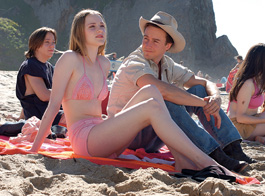home | metro silicon valley index | movies | current reviews | film review

A Day at the Beach: Harlan (Ed Norton) and Tobe (Evan Rachel Wood) get away from it all in 'Down in the Valley.'
L.A. Rustler
Ed Norton's cowboy romances drifting teen Evan Rachel Wood in urban Western 'Down in the Valley'
By Richard von Busack
AS AN example of the craft of direction and acting, David Jacobson's Down in the Valley has its points. As an example of a director and his actors all pulling in different directions, Down in the Valley serves as a real cautionary tale.
This is a quintessential Sundance Movie: Family Trusses Itself Together in Front of Glorious Western Landscape. At times—at its best times—the film offers compelling doomed outlaw romance. At other times, the film is like the proverbial hero that got on his horse and rode off in all directions.
San Francisco.com Real Estate
Moving to the Bay Area just became easy. Let San Francisco.com show you all the homes currently for sale.
San Jose.com Real Estate
Relocating to San Jose or Silicon Valley? Let San Jose.com introduce you to some expert area real estate agents.
Tobe (short for October and played by Evan Rachel Wood) is drifting out of her father's control. He, Wade (David Morse), is a prison guard single-parenting Tobe and her pale, passive little brother, Lonnie (Rory Culkin). The unhappy family lives in a small house within roaring distance of the Hollywood-Burbank airport. We hear the thrumming of the nearby freeway, never out earshot.
On a beach trip, Tobe and some friends stop at a gas station and meet a cowboy pump jockey named Harlan (Edward Norton). Harlan has never been to the beach, and so he impulsively quits his post and goes along with them.
Harlan seems too good to be true. "Are you for real," Tobe asks. Harlan replies, "I think so." He is almost wincingly courtly, although he is years older than Tobe. But Tobe proves to be bold for 16 (just as Wood was bold for her role in Thirteen). Here, she lays her art-deco-slim body on a beach blanket.
Wade gets suspicious, but it isn't much longer until we discover how vague the boundary is between "sensitive" and "crazy." The only ranch Harlan's been near is an outfit called the Section 8; in his shacklike apartment, he practices his fast draw in front of the mirror.
Wade keeps his own collection of firearms, so we can expect a showdown. But like Harlan, Wade also owns a guitar and evinces a love of cowboy music.
At times, Down in the Valley looks like someone trying to film the subtext of Red River without filming the text.
Jacobson's valleyscapes are compelling, with a plane plummeting into the airport in a telephoto shot, like an excerpt of the jumbo-jet ballet in Koyaanisqatsi. The first shot of Harlan's gas station is so splayed out in widescreen that it looks like one of Ed Ruscha's paintings of Standard Oil stations. The finale, a gunfight in the midst of a half-constructed Antelope Valley housing track, is the kind of inspired daydream that ought to have been fixed to a looser plot.
Down in the Valley is essentially a romance between an outlaw and the sheriff's daughter. But there is a level of uncertainty here, of half-thought-of subplots. We are never giving a chance to understand why Harlan re-created himself as a cowboy in the first place.
He is a former Black Flag fan (we see Harlan's tattooed shoulder), and he might have been Yeshiva boy—or is there some other explanation for Harlan's sudden appearance at a Jewish temple? And there is an instant where it really looks like Norton is improvising out of control; it comes when he starts to restage the De Niro's "Giving my reflection the third degree" routine from Taxi Driver. It's as if Jacobson thought the bit was too good to leave out, whether it fit or not.
In any case, Norton makes a convincing cowboy. When he uses some clothesline to loop a hackamore for a horse, he looks as if he has done it a hundred times. And he rides well in the scene when he takes Tobe out into the hills through the scrub up to the radio antennas.
Down in the Valley works best as a fantasy of trying to conduct yourself as a cowboy in modern-day L.A., by turning a blind eye to how the mountains are being carved up for minimansions. But the difference between reality and fantasy doesn't need to be stressed by a local rancher (Bruce Dern). He gets bent out of shape when Harlan borrows his horse for that ride into the hills, declaring, "This ain't the old West." Even in the old West, horse borrowing could be a hanging matter. (That dern Dern was in enough Westerns to know that.)
When Down in the Valley drifts back from the romance, it turns into a story of an outraged dad asserting familial authority. Oddly, Down in the Valley comes out in favor of family bonding rather than crazy love. A love story was its best bet, however, because the film doesn't show much common sense. It can't really stand divided, half-romantic, half-pragmatic. The way it plays out, Down in the Valley will please neither half of the audience: neither the half longing for doomed romance nor the half wanting to see a movie about out-of-control teenagers learning to toe the line.
![]() Down in the Valley (R; 114 min.), directed and written by David Jacobson, photographed by Enrique Chediak and starring Edward Norton and Evan Rachel Wood, opens May 19 at selected theaters.
Down in the Valley (R; 114 min.), directed and written by David Jacobson, photographed by Enrique Chediak and starring Edward Norton and Evan Rachel Wood, opens May 19 at selected theaters.
Send a letter to the editor about this story.
|
|
|
|
|
|
